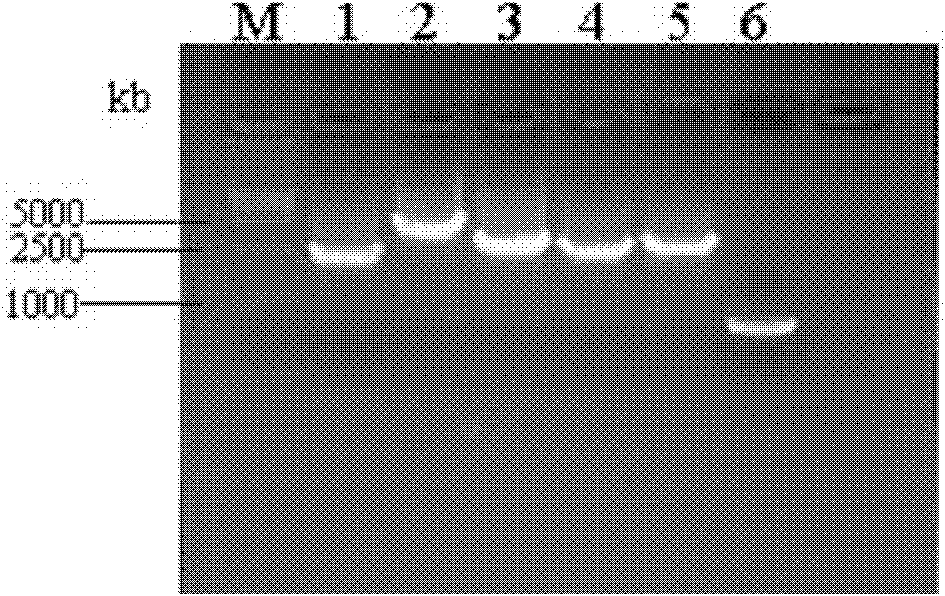Vaccine strains of infectious clones of porcine reproductive and respiratory syndrome virus (PRRSV) and application thereof
A technology for respiratory syndrome and pig breeding, applied in the field of bioengineering, can solve problems such as large immunization dose of inactivated vaccines, unsatisfactory immunization effect of heterologous strains, safety concerns, etc., and achieve an effect that is conducive to prevention and control
- Summary
- Abstract
- Description
- Claims
- Application Information
AI Technical Summary
Problems solved by technology
Method used
Image
Examples
Embodiment 1
[0047] Example 1 Construction of full-length cDNA clone of porcine reproductive and respiratory syndrome virus vaccine strain HuN4-F112 genome
[0048] 1. Materials and methods
[0049] 1.1 Viruses, vectors and reagents
[0050] The PRRSV vaccine strain F112 was attenuated and preserved by the laboratory (Tong Guangzhi et al. 2007; Tong GZ et al., 2007; Zhou YJ et al., 2008; Tian ZJ et al., 2009), cloning vector pBulescriptII SK(+) Was purchased from Fermentas; RNeasy Plus Mini Kit was purchased from QIAGEN; gel recovery kit was purchased from Shanghai Huashun Biotechnology Co., Ltd.; SupersciptIII reverse transcriptase and pfx DNA polymerase was purchased from Invitrogen; RNase H, T4 DNA ligase, and restriction endonuclease were purchased from NEB; DL-15000, DL-2000 DNA Marker were purchased from TakaRa; other chemical reagents were imported or domestically pure.
[0051] 1.2 Primer
[0052] According to the whole genome sequence of PRRSV HuN4 strain (GenBank accession number: EF6350...
Embodiment 2
[0070] Example 2 Rescue and identification of porcine reproductive and respiratory syndrome virus
[0071] 1. Method
[0072] 1.1 RNA synthesis and transfection in vitro
[0073] Linearize the plasmid pSK-HuN4-Vac containing the full-length cDNA using the SwaI restriction site introduced by the 3'end Poly(A) tail, and synthesize viral RNA according to the instructions of the mMessage High Yield Capped RNA Transcription kit in vitro transcription kit. Inoculate BHK21 cells and perform transfection according to the instructions of DMRI-C transfection reagent when the cell density is 70% to 90%.
[0074] 1.2 Identification of rescue virus
[0075] 1.2.1 RT-PCR detection of genomic markers (genomic marker)
[0076] The RNA of the clonal virus cHuN4-Vac and the parental virus HuN4-F112 infected cells was extracted, reverse transcribed, and the fragments containing MIulI were amplified by primers JD1 and JD2, and the MIulI was used for restriction digestion identification, and the pMD18-T vec...
Embodiment 3
[0086] Example 3 Animal Test
[0087] 1. Animal test methods:
[0088] Fifteen 40-day-old healthy piglets negative for PRRS virus and antibodies, and negative for PRV, PCV2 and CSFV, were randomly divided into 3 groups, namely the HuN4-F112 vaccine control group, the artificial clonal virus cHuN4-Vac vaccine group and the blank control group. There are 5 pigs in each group, and each pig in the artificial clonal virus vaccine group has a dose of 10 5.0 TCID 50 In the HuN4-F112 vaccine control group, each pig was vaccinated according to the vaccine instruction manual, and the blank control group was vaccinated with DMEM. 28 days after inoculation, all test pigs attacked HuN4-F5 virulent 3×10 each 4.0 TCID 50 Observe the clinical manifestations and temperature every day after the challenge. Blood samples are taken on days 0, 1, 3, 7, 14, 21, and 28 to detect antibody levels, isolate the virus and perform differential diagnosis tests on it, and perform pathological tissues on the test ...
PUM
 Login to View More
Login to View More Abstract
Description
Claims
Application Information
 Login to View More
Login to View More - R&D
- Intellectual Property
- Life Sciences
- Materials
- Tech Scout
- Unparalleled Data Quality
- Higher Quality Content
- 60% Fewer Hallucinations
Browse by: Latest US Patents, China's latest patents, Technical Efficacy Thesaurus, Application Domain, Technology Topic, Popular Technical Reports.
© 2025 PatSnap. All rights reserved.Legal|Privacy policy|Modern Slavery Act Transparency Statement|Sitemap|About US| Contact US: help@patsnap.com



